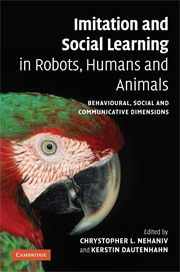 Imitation and Social Learning in Robots, Humans and Animals
Imitation and Social Learning in Robots, Humans and Animals Book contents
- Frontmatter
- Contents
- List of plates
- List of figures
- List of tables
- List of contributors
- Introduction: the constructive interdisciplinary viewpoint for understanding mechanisms and models of imitation and social learning
- Part I Correspondence problems and mechanisms
- Part II Mirroring and ‘mind-reading’
- Part III What to imitate?
- Part IV Development and embodiment
- Part V Synchrony and turn-taking as communicative mechanisms
- Part VI Why imitate? – Motivations
- Part VII Social feedback
- Part VIII The ecological context
- Index
- Plate section
- References
Introduction: the constructive interdisciplinary viewpoint for understanding mechanisms and models of imitation and social learning
Published online by Cambridge University Press: 10 December 2009
- Frontmatter
- Contents
- List of plates
- List of figures
- List of tables
- List of contributors
- Introduction: the constructive interdisciplinary viewpoint for understanding mechanisms and models of imitation and social learning
- Part I Correspondence problems and mechanisms
- Part II Mirroring and ‘mind-reading’
- Part III What to imitate?
- Part IV Development and embodiment
- Part V Synchrony and turn-taking as communicative mechanisms
- Part VI Why imitate? – Motivations
- Part VII Social feedback
- Part VIII The ecological context
- Index
- Plate section
- References
Summary
Introduction
Social learning, matched behaviour and imitation are important classes of mechanisms whereby knowledge may be transferred between agents (biological, computational or robotic autonomous systems). They comprise key mechanisms necessary for the evolution and development of social intelligence and culture. Researchers from across disciplines have begun coming together to understand these mechanisms with ever more sophisticated models.
While the importance of Social Learning has grown increasingly apparent to psychologists, ethologists, philosophers, linguists, cognitive scientists and computer scientists, biologists, anthropologists and roboticists, the workers in the field are often unaware of relevant research by others in other disciplines. Social learning has lacked a rigorous foundation and only very few major interdisciplinary publications have been available on the subject for researchers in artificial intelligence or psychology interested in realizations of the mechanisms they study. By bringing social learning techniques into computer and robotic systems, the door is being opened for numerous applications that will allow the acquisition of skills, programs and behaviours automatically by observation in human–computer interfaces (e.g. Lieberman, 2001), human–robot interaction important in service robotics and other applications where robot assistants or companions need to learn from humans, and industrial applications such as automated factory floors in which new robots can acquire skills by observing the behaviour of other robots or humans. Models from psychology and biology are being validated and extended as scientists from these fields interact with collaborators from sciences of the artificial, while the latter benefit from the insight of their colleagues in the natural and social sciences in the harnessing of social learning in constructed systems.
Information
- Type
- Chapter
- Information
- Imitation and Social Learning in Robots, Humans and AnimalsBehavioural, Social and Communicative Dimensions, pp. 1 - 18Publisher: Cambridge University PressPrint publication year: 2007
References
Accessibility standard: Unknown
Why this information is here
This section outlines the accessibility features of this content - including support for screen readers, full keyboard navigation and high-contrast display options. This may not be relevant for you.Accessibility Information
- 5
- Cited by